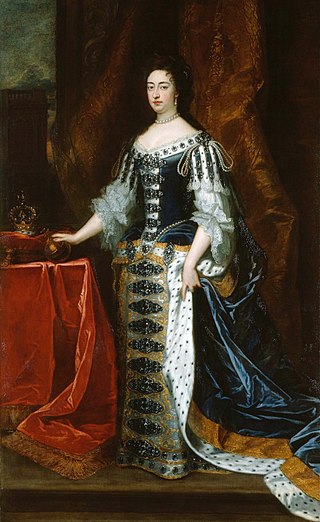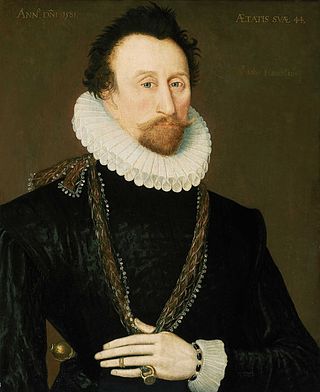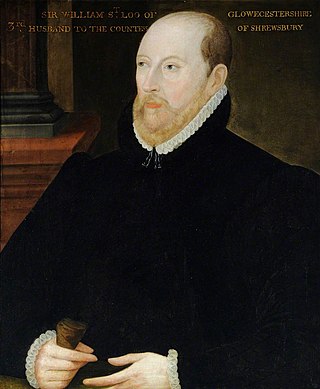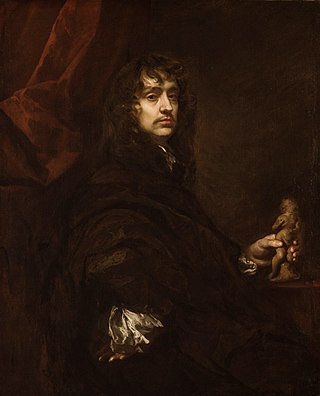Related Research Articles

Elizabeth I was Queen of England and Ireland from 17 November 1558 until her death in 1603. She was the last monarch of the House of Tudor.

Mary II was Queen of England, Scotland, and Ireland, co-reigning with her husband, William III and II, from 1689 until her death in 1694. She was also Princess of Orange following her marriage on 4 November 1677. Her joint reign with William over Britain is known as that of William and Mary.

The House of Tudor was an English and Welsh dynasty that held the throne of England from 1485 to 1603. They descended from the Tudors of Penmynydd, a Welsh noble family, and Catherine of Valois. The Tudor monarchs ruled the Kingdom of England and the Lordship of Ireland for 118 years with five monarchs: Henry VII, Henry VIII, Edward VI, Mary I and Elizabeth I. The Tudors succeeded the House of Plantagenet as rulers of the Kingdom of England, and were succeeded by the House of Stuart. The first Tudor monarch, Henry VII, descended through his mother from the House of Beaufort, a legitimised branch of the English royal House of Lancaster, a cadet house of the Plantagenets. The Tudor family rose to power and started the Tudor period in the wake of the Wars of the Roses (1455–1487), which left the main House of Lancaster extinct in the male line.

1694 (MDCXCIV) was a common year starting on Friday of the Gregorian calendar and a common year starting on Monday of the Julian calendar, the 1694th year of the Common Era (CE) and Anno Domini (AD) designations, the 694th year of the 2nd millennium, the 94th year of the 17th century, and the 5th year of the 1690s decade. As of the start of 1694, the Gregorian calendar was 10 days ahead of the Julian calendar, which remained in localized use until 1923.

Greenwich is a town in south-east London, England, within the ceremonial county of Greater London. It is situated 5.5 miles (8.9 km) east-south-east of Charing Cross.

Thomas Howard, 4th Duke of Norfolk, was an English nobleman and politician. He was a second cousin of Queen Elizabeth I and held many high offices during the earlier part of her reign.

Sir John Hawkins was an English naval commander, naval administrator, privateer and slave trader.

Henry Howard, 1st Earl of Northampton was an important English aristocrat and courtier. He was suspected throughout his life of being Roman Catholic, and went through periods of royal disfavour, in which his reputation suffered greatly. He was distinguished for learning, artistic culture and his public charities. He built Northumberland House in London and superintended the construction of the fine house of Audley End. He founded and planned several hospitals. Francis Bacon included three of his sayings in his Apophthegms, and chose him as "the learnedest councillor in the kingdom to present to the king his Advancement of Learning." After his death, it was discovered that he had been involved in the murder of Sir Thomas Overbury.

Matthew Stewart, 4th Earl of Lennox was a leader of the Catholic nobility in Scotland. He was the paternal grandfather of King James VI of Scotland. He owned Temple Newsam in Yorkshire, England.

Sir Peter Lely was a painter of Dutch origin whose career was nearly all spent in England, where he became the dominant portrait painter to the court. He became a naturalised British subject and was knighted in 1679.
Events from the year 1819 in the United Kingdom.
Events from the year 1664 in England.
Events from the year 1660 in England. This is the year of the Stuart Restoration.
Events from the year 1689 in England.
Events from the 1530s in England.
The Treaty of Greenwich contained two agreements both signed on 1 July 1543 in Greenwich between representatives of England and Scotland. The accord, overall, entailed a plan developed by Henry VIII of England to unite both kingdoms. The first sub-treaty helped to establish peace between the Kingdom of England and the Kingdom of Scotland. The second sub-treaty was a marriage proposal between Edward VI of England and Mary, Queen of Scots. In this part of the treaty, it was agreed that Mary would be accompanied by an English nobleman/gentleman until she was ten years old. Afterwards, Mary would reside in England until the time of her marriage. Also, the Treaty of Greenwich permitted the Kingdom of Scotland to maintain its laws. Even though the Earl of Arran signed the accord on 1 July and ratified it on 25 August 1543, the Treaty of Greenwich was ultimately rejected by the Parliament of Scotland on 11 December 1543, leading to eight years of Anglo-Scottish conflict known as the Rough Wooing.
Events from the 1390s in England.
Events from the 1550s in England. This decade marks the beginning of the Elizabethan era.
Events from the 1690s in the Kingdom of Scotland.
References
- 1 2 3 Williams, Hywel (2005). Cassell's Chronology of World History . London: Weidenfeld & Nicolson. ISBN 0-304-35730-8.
- ↑ Penguin Pocket On This Day. Penguin Reference Library. 2006. ISBN 0-14-102715-0.
- ↑ "Greenwich Hospital" . Retrieved 2012-03-07.
- ↑ "Lottery Office records". The National Archives. Retrieved 2023-10-18.
- ↑ "Mary II | Biography & Accomplishments | Britannica". www.britannica.com. Retrieved 4 May 2022.